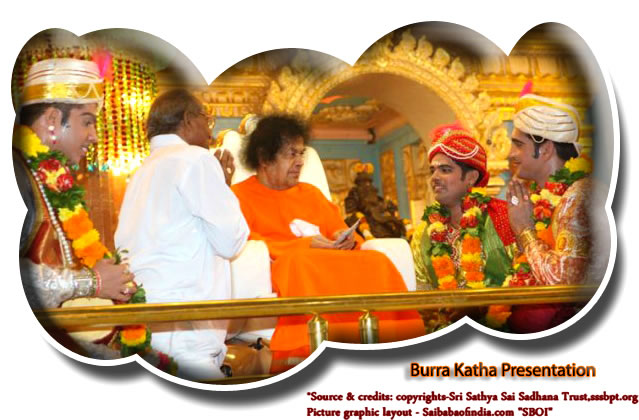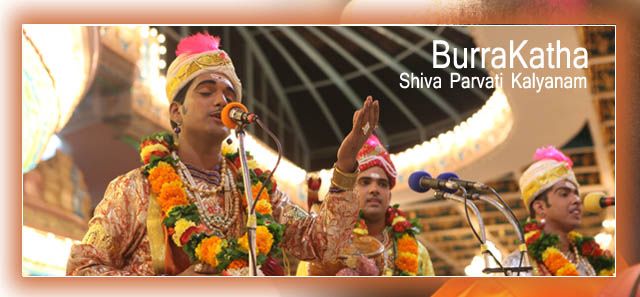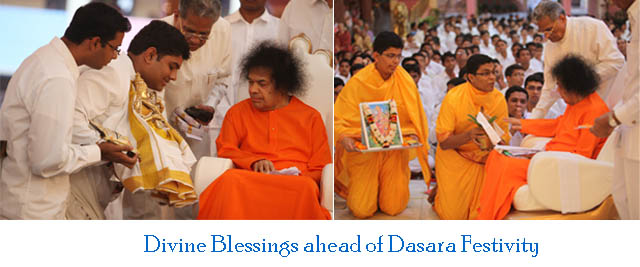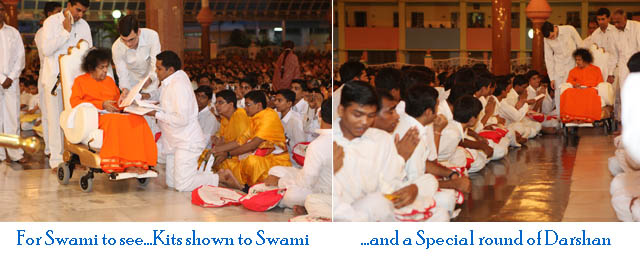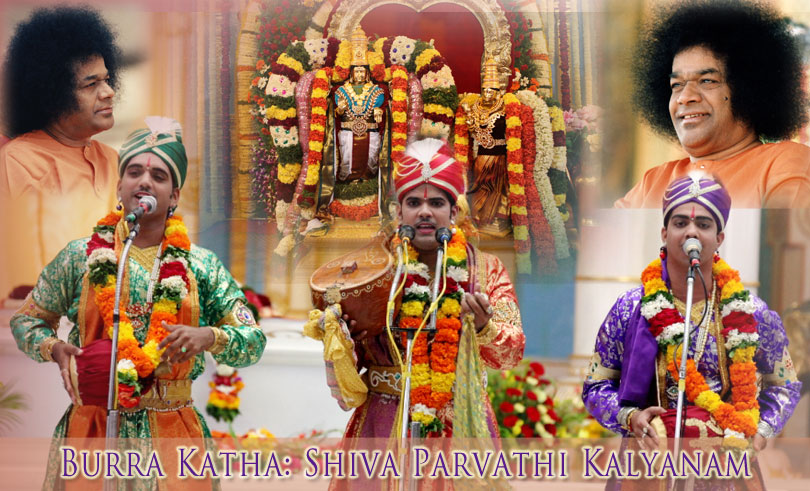
|
Prasanthi News - Samadhi & Prasanthi Events |
|||
|
Text & photo source - copyrights: Sri Sathya Sai Sadhana Trust - sssbpt.org - Radiosai.org Prasanthi Diary - theprasanthireporter.org | Web layout - Photo graphic design : saibabaofindia.com "SBOI" | - We gratefully acknowledge the publishers Sri Sathya Sai Sadhana Trust & Sri Sathya Sai Media Foundation |
|||
|
|
|||
|
Alumni of the Sri Sathya Sai Institute of Higher Learning, ably
guided by their Guru Sri M. Krishna Bhaskar, who have frequently performed the
Burra Katha in Bhagawan’s Divine presence, presented an encore of the ‘Shiva
Parvathi Kalyanam’ today to commence the Sivaratri Festivities in Prasanthi
Nilayam.
Click
here for the link to the previous occasion on which the trio performed the
same theme in the Divine Presence. Burra in Telugu means skull or head. In this context it refers to a musical instrument similar to a Thambura, with strings and hollow round base similar to the head. ‘Katha’ means story. So Burra Katha is an entertaining musical narrative which consists of small songs, poems and dialogue. But what makes it as popular as it is, is the humorous manner in which the theme is rendered. The troupe consists of one main performer and two co-performers.The main performer, the Kathakudu, renders the entire theme, in song, all the while, playing on the Tambura and dancing to music. He also plays a small rhythm instrument called andelu. The performer on the left side of the kathakudu is called hasyaka - he is the humorist. On the right side of the kathakudu is the rajakiya. He is the knowledgeable narrater who brings out the entire theme as a conversation with the hasyaka. The co-performers play an instrument called gummeta (also referred to as dakki), an earthen drum with two heads. All three wear anklets or gejjelu. This art form was instrumental in arousing nationalist feelings during the Indian independence movement and is a very effective communication tool. However, it was a dying art form as patronage was in acute scarcity in this technological era. That was when Swami stepped in and resurrected it! Today it flourishes in Prasanthi Nilayam due to Bhagawan’s deep involvement and appreciation. Shiva Parvathi Kalyanam is the story leading to the cosmic wedding of Lord Shiva and His equal half Parvathi. The trio started the programme with songs in praise of Lord Ganesha and Bhagawan Baba. They start the story with the past life of Parvathi when born as Sati, she marries Shiva against the will of her father Daksha. Daksha conducts an Yajna without inviting his son in law. Sati attends the Yajna without being invited and is insulted by her father. Sati immolates herself in shame and Shiva takes revenge by destroying the Yajna through Veerabhadra. Sati is reborn as Parvathi to Himavanta, the lord of the mountains and a great and kind hearted king. Sage Narada approaches Himavanta and suggests that Parvathi should be married to Shiva for the sake of the welfare of the world or Loka Kalyanam. Parvathi prays to Shiva and with a basket of flowers walks to where Shiva is meditating. Urged by Indra deva, Kama (Cupid) disturbs Shiva’s meditation and is destroyed by His third eye. Seeing the sight, Parvathi faints and Shiva walks back to Kailasa. Shiva comes back in disguise as a story teller (Yerukala Saani) to the capital of Himavanta’s kingdom. Summoned by Parvathi he sings a song praising her bridegroom. He comes back as a old brahmin and tells her that they have to get married as the stars deem so. Parvathi says she will marry only Shiva and none else. Her mother describes the various undesirable aspects of Shiva’s appearance and lifestyle and says that she should permit them to look for a better match but Parvathi is adamant. Pleased Shiva appears in their presence and consents for the wedding. Sapta Rishis chose the Muhurtam, Viswakarma builds the halls and sculpts the mangala sutra, Lord Vishnu performs the Kanya Daanam with Lord Brahma being the Yajna Kartha. Thus concluded the auspicious story of Shiva Parvathi Kalyanam in the Divine Sannidhi of the Shiva-Shakthi Swaroopa, Bhagawan Sri Sathya Sai Baba. A Bhajan “Anandame Sai Bhajana“, much enjoyed by Bhagawan brought the curtains down on the programme. The trio Sri Prabakar, Sri Aravind Sai and Sri Raghu Ram were ably supported by Sri Sai Dutt on the Mridangam, Sri Neelakantan on the Flute, Sri Sai Prakash on the Sitar, Sri Yaman on the Violin, Sri Nishit Shah on the Harmonium, Sri Shailesh Srivatsava and Sri Sai Krishna on the Keyboard and Sri Harish Kovil on the Conch and the Kanjira.
|
|||
|
Thursday, Oct 15, 2010
|
|||
|

